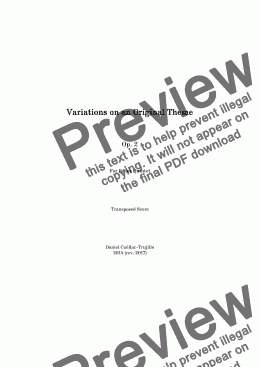Ready to print
You have already purchased this music, but not yet printed it.
This page is just a preview and does not allow printing. To print your purchase, go to the My purchases page in your account and click the relevant print icon.

Already purchased!
You have already purchased this score. To download and print the PDF file of this score, click the 'Print' button above the score. The purchases page in your account also shows your items available to print.
This score is free!
Buy this score and parts
Variations on an Original Theme, Op. 2
$11.25
$5.62
$5.63
from $1.50
Preview individual parts:
Instant download
You are purchasing high quality sheet music PDF files suitable for printing or viewing on digital devices.Audio recording available on YouTube and SoundCloud
This piece consists on a series of variations in a tonal/modal harmonic language. It explores different simple rhythmic and harmonic concepts, along with atmospheres and textures inspired in a rather romantic style, to create a composition that is pleasant both to the audience and to the performers, although it demands some degree of virtuosity from the players. The main theme is bright, energic, in a fanfare style. It recalls the concert band music of North American tradition, with harmonic, rhythmic and melodic gestures full of energy and jollity. The first variation’s metre changes to a ternary beat, and it explores the harmonic possibilities of keeping a pedal note during most of the section’s length. The second variation is based upon the concept of number five, both from a rhythmic standpoint (time signature of 5/4, and quintuplets) and from a harmonic standpoint (pentatonic scales). The third variation poses a three-beat dance rhythm, and, instead of literally repeating the music corresponding to the theme’s first part, the whole section is written down again; this written repetition adds fast upward figurations of triplets and quintuplets. The fourth variation evokes a march in a style that could be associated with Gypsy or Eastern European music. The theme is transformed with a time signature of 7/4 and scales with augmented seconds (that create a somewhat “Arabic” character). The fifth variation presents a version in the minor mode, with a ternary rhythm. The repetition of the first section is also written down in this variation, and it introduces an increasingly complex rhythmic pattern of repeated notes in the trumpets. The sixth variation serves as a connection with the last section of the piece, and it explores quartal harmonies, emulating the style of North American brass ensembles. The seventh and last variation begins with a brief introduction based on a call da lontano, quite recurring in the brass parts of many compositions of the universal repertoire. The variation itself consists on a harmonization of the theme, without any repetitions, in which the original melody undergoes a rhythmic augmentation, so that each note lasts for an entire bar.
Copyright © 2014 Daniel Cuéllar-Trujillo. All rights reserved.
This work is registered with CopyrightHouse.org. Registration ID: 2096174



